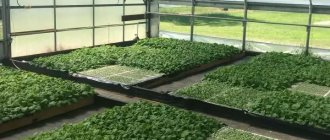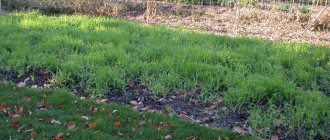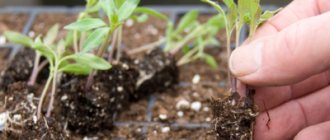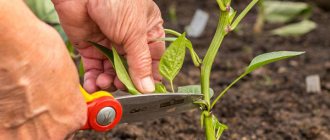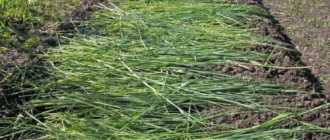Growing a good harvest of fruits and vegetables is not an easy task. Most crops require fertile soils, but few people have black soil on their plot - most often clay. Moreover, gardeners and vegetable gardeners are constantly plagued by diseases and pests. You work all summer, planting, watering, feeding, but the harvest is nothing. And hands give up...
Let them go down. But in bags with green manure seeds. This group of plants can work wonders - they increase fertility and help get rid of pathogens. Let's find out what kind of green manure there are, what they do and how to use them.
What are green manures?
Green manure is a group of plants that are grown as a natural fertilizer. They are allowed to grow, after which they are embedded in the soil - the green mass is cut off, scattered evenly over the site and then dug up (1). Gradually, it decomposes and saturates the soil with useful elements, which are subsequently used by cultivated plants (2).
This is an environmentally friendly fertilizer and, moreover, a safe plant protection product. Many green manures can be sown from spring to autumn, for example, in areas from which the crop has already been harvested. Or in the garden, under fruit trees and between berry bushes.
Conclusion
Green manure is an inexpensive and accessible way to restore the land and increase the yield of almost any crop. You can use green fertilizers both before each planting and throughout the whole year to restore completely depleted land.
Related Materials:
- When to sow white mustard on green manure
Application of green manure in a greenhouse in autumn
When to plant green manure to get the maximum benefit from growing them
What green manures are suitable for onions?
The benefits of green manure
Green manures are called green fertilizers, but in fact they have much more beneficial properties.
Increases soil fertility. These plants grow green mass very quickly, and when it is embedded in the soil, it gradually decomposes. As a result, humus is formed - the basis of fertility (3). The more often you sow green manure, the more humus there will be. And where there is a lot of humus, beneficial soil microorganisms and earthworms actively multiply, which also increase fertility.
Improves soil structure. The root system of many types of green manure penetrates deeply into the soil and improves its structure - making it loose, permeable to water and air (3).
Suppresses the growth of weeds. Green manure plants quickly grow leaves, and since they are sown densely, they create a fairly dense shade. And without light, weeds cannot grow. In addition, some species secrete special substances into the soil that inhibit the germination of seeds of harmful plants (4).
Reduces the number of diseases and pests. Some green manures emit substances that repel pests (4). For example, radish rids the area of nematodes, and mustard suppresses the development of scab.
Helps increase yield. Many green manures are also good honey plants - they attract pollinating insects, which at the same time pollinate vegetable plants, fruit trees and berry bushes. This means that more fruit will be produced. In addition, productivity increases due to the saturation of the soil with organic matter, and, as experiments have shown, green manure is more profitable than manure because it is cheaper (5).
Rules for planting green manure crops
Just a few years ago, experts insisted: green manure crops, which were planted in order to enrich the soil with organic matter and other benefits, must be mowed down to the roots and literally buried in the ground. Very little time has passed, and views on this procedure have changed. And radically.
Let's first figure out why digging up soil along with planting green manure crops is not recommended.
- Violation of the fertile soil layer. The layer of soil that is fertile is not as large as you think. Green manure crops were sown by you precisely in order to form a fertile layer or improve it. If you dig deep, you will destroy with your own hands what the green manure crops created.
- Raising weed seeds to the top. While green manure grew in the ground, the weed seeds had to sit quite deep in the ground. They would have sprouted with great pleasure, but did not have the opportunity to do so. Why? Yes, because the path to the surface was blocked by the root system of green manure plants. If you dig up the soil in order to cover up green manure, the weed seeds will immediately be raised to the surface with your own hands. Is it worth talking about what happens next?
- Closing the road for moisture. Organic matter that is buried too deep into the soil unfortunately becomes a serious barrier to moisture. The water could easily go deeper, but because of the buried organic matter, it simply cannot do this. As a result, the fertile layer of the earth is eroded due to precipitation, which practically does not stop in the fall. The top layer of soil becomes mushy. Later, when precipitation subsides, the soil begins to dry out. As a result, it is completely deprived of moisture, and the organic matter, which is embedded in the depths, is deprived of oxygen due to the dry soil. And as a result, instead of qualitatively rotting, it begins to sour.
What's the solution? According to recent research, green manure crops do not need to be buried deep in the ground. They need to be dug up using a flat cutter so that embedding into the soil is minimal - to a depth of eight to ten centimeters. In this case, the remains of green manure fall into the fertile soil layer and continue to do what they are intended for without hindrance. Only in this way can it be ensured that part of the green manure plants gets into the fertile layer and begins to work as organic matter, while the other part remains on the surface and acts as mulch.
With a competent approach, planning the sowing, mowing and burying of green manure crops must be no less careful than crop rotation in summer cottage beds. A sober and balanced approach to this phenomenon and action guarantees the most effective results from the use of green manure plants.
TOP 10 best green manures for the vegetable garden according to KP
There are quite a lot of plants that can be used as green manure. Most of them belong to 3 groups of plants:
- legumes;
- cereals;
- cruciferous
But there are representatives of other families.
Vika
Vika.
Photo: George Zakharchuk, globallookpress.com This legume plant helps accumulate nitrogen in the soil. On its roots there are nodules in which nitrogen-fixing bacteria live - they capture atmospheric nitrogen from the air and convert it into a form accessible to plants. In addition, vetch also makes phosphates available. It also protects the soil from erosion.
Spring varieties are sown during June. Winter vetch - at the end of October. The norm is 15 g of seeds per 1 sq. m. Since vetch is a climbing plant, it is better to sow it in a mixture with other green manure: oats, barley, mustard, rapeseed or phacelia.
It can be used in any area, except for beds where legumes grew - peas, beans, beans.
Lupine
Lupine.
Photo: pixabay.com Another legume plant and also an excellent green manure. Even on poor soils, it grows a lot of green mass - up to 400 kg per hundred square meters! This means that it perfectly enriches the soil with organic matter. In addition, like all legumes, it saturates it with nitrogen (up to 200 g per 1 sq. m.) and converts phosphorus into a form accessible to plants. Its roots penetrate very deeply, up to 2 m, and from there they extract minerals that are inaccessible to many vegetables with a shallow root system (for example, tomatoes and peppers). It loosens the soil perfectly. Repels mole crickets and cockchafer larvae. And on top of that, it looks very nice. But let’s make a reservation right away: not perennial lupins, which are grown in flower beds, are used as green manure (they also have useful properties, but are still intended for admiring, and not planting in the soil), but annual ones.
Lupine is sown in April or August, but it is better at the end of summer. The norm is 15 - 20 g per 1 square. m. Mow it 1.5 months after germination.
You cannot sow lupine after legumes. And after the rest - it is possible and necessary.
Clover
Clover.
Photo: pixabay.com 3 types of clover are used as green manure:
- white clover;
- red clover;
- pink clover (hybrid).
Like all legumes, these types of clovers enrich the soil with nitrogen. In addition, they protect it from erosion and are good honey plants, attracting beneficial insects to the site. They can be sown in the garden, and also used instead of a lawn.
All types of clover can be sown from April to August. The norm is 1 - 2 g per 1 sq. m. Mow 2 weeks before planting vegetables. White clover, since it has creeping shoots and they lie down, is better sown in a mixture with timothy grass, phacelia or spring grain crops - this will produce more green mass.
You cannot sow after legumes. An excellent green manure for the garden.
Alfalfa
Alfalfa.
Photo: Joanna Boisset, commons.wikimedia.org Two types of alfalfa are used as green manure:
- blue alfalfa;
- yellow alfalfa.
Both of them enrich the soil with nitrogen - if you sow alfalfa in one place for 3 years in a row, then after mowing and digging, in total they will give the same amount of nitrogen as half a ton of manure per hundred square meters. In addition, alfalfa improves soil structure and reduces its acidity.
You can sow alfalfa in 2 terms:
- from April 20 to May 15;
- from July 15 to August 15.
Sowing rate – 1.5 g per 1 sq. m. Mow it after 1.5 months.
Alfalfa is good as a precursor for any vegetable crops except legumes.
Phacelia
Phacelia.
Photo: pixabay.com This is one of the most popular green manures and this is no coincidence. It grows very quickly and blooms within 6 weeks after germination. And it blooms profusely and spectacularly, and the inflorescences of the phacelia are very unusual - they look like curls. Excellent decoration for the site! Perkasny honey plant - pollinating insects flock to it en masse. At the same time, it repels wireworms, nematodes, caterpillars, woodlice and locusts, and significantly reduces the number of aphids, weevils and grains. It also deoxidizes the soil, making it neutral – this is exactly what is needed for most vegetables.
Phacelia can be sown from the end of March to the end of August, or before winter. The norm is 8 - 10 g per 1 sq. m. You can mow after 1 - 1.5 months.
It can be grown after any crops, but it gives the greatest effect after tomatoes, potatoes and cucumbers.
Mustard
Mustard.
Photo: Hecker, globallookpress.com It loosens the soil, fills it with organic matter, but most importantly, it suppresses the proliferation of pests and diseases. Its roots release sulfur into the soil, which repels mole crickets, May beetle larvae, wireworms, slugs and has a depressing effect on pathogenic fungi, including the causative agents of late blight and fusarium. Mustard comes in different types; white mustard and Sarepta mustard are most often used as green manure (5).
You can sow mustard throughout the summer and before winter. The norm is 1.5 - 2 g per 1 sq. m. Mow it after 40 days - before the buds appear.
Mustard cannot be sown after cruciferous plants - cabbage, radishes, radishes, turnips. After other crops it is possible and necessary, but it is especially good after potatoes - it heals the soil.
Rape
Rape.
Photo: Torsten Sukrow, globallookpress.com There are 2 types of rapeseed: spring and winter, they are sown at different times, but they work the same way - they enrich the soil with organic matter, phosphorus and sulfur. Attracts bees and other pollinating insects. In addition, rapeseed destroys wireworms and suppresses the development of pathogens of potato diseases - scab and rhizoctonia. And winter rapeseed also retains snow on the site.
Spring rapeseed is sown in mid-April. Winter - in the second half of August. Seeding rate – 1.5 g per 1 sq. m. Spring crops are mowed after 1 - 1.5 months. Winter - in spring, at the end of April.
An excellent precursor for potatoes - experiments have shown that after rapeseed, the infestation of potato plantings decreases by 17.3% (4). You cannot sow cruciferous plants before or after: cabbage, radishes, radishes, turnips, daikon.
Radish
Radish.
Photo: Christian Hütter, globallookpress.com This is not the kind of radish that we grow for its root vegetables, this one is an oilseed one. It perfectly loosens the soil, enriches it with organic matter, but most importantly, it disinfects the area: it helps get rid of wireworms and nematodes, suppresses the development of potato diseases (scab and rhizoctonia), the growth of wheatgrass and other weeds.
Oilseed radish can be sown 3-4 times per season - from April to August. You can sow it before winter. The norm is 3 - 4 g per 1 sq. m. Mow it after 1.5 - 2 months, or in the spring if it was sown in October - November.
An ideal predecessor for potatoes. You cannot sow before or after cruciferous vegetables.
Oats
Oats.
Photo: pixabay.com In addition to organic matter, it also saturates the soil with potassium. And its roots contain substances that prevent the development of root rot and repel nematodes. Perfectly loosens the top layer of soil.
Oats are sown 2 times per season - in spring and August. Norm – 130 – 200 g per 1 sq. m. Cut it off when the plants reach a height of 15 cm.
After oats, it is good to plant tomatoes, peppers and eggplants. But it is undesirable to plant and sow root crops and potatoes after it - wireworms can settle in their roots.
Winter rye
Winter rye.
Photo: pixabay.com It enriches the soil with organic matter, nitrogen and potassium. But most importantly, it suppresses the development of the most malicious weed - creeping wheatgrass. This is why winter rye is often used when developing new areas - in the fall, virgin soil is dug up and sown with this grain.
Sowed from August 25 to September 20. The norm is 20 g per 1 sq. m. Mow in the spring or summer of next year.
Winter rye is an ideal predecessor for any vegetables. But it cannot be sown after cereals, such as corn.
The basic rule for embedding into the soil
Deep plowing of green manure is wrong. At great depths, plants decompose poorly. Fresh organic matter blocks the way for moisture to flow from the upper layers of the soil. Without access to oxygen, the green mass inside the soil does not rot, but turns sour.
Tomato shoots and other “garbage” from the garden that can be used for the benefit of plants
When to sow green manure
Most green manures are cold-resistant plants, so they can be sown from early spring to the end of August. Even when sown at the end of summer, they have time to bring benefits, since they are usually mowed after 1.5 months, that is, in this case, in mid-October. And this is just the right time to dig up the soil.
And some green manures can be sown before winter.
in spring
In spring, green manure can be sown from mid-April, and in the southern regions or in early spring - from the end of March.
If vegetables are supposed to be sown late, for example, some rare varieties and daikon are sown in July, then green manure can be sown later - in May.
In summer
In summer, green manure can be sown from the beginning of June until the end of August. In this case, they are usually sown in areas from which the crop has already been harvested. For example, if you have harvested radishes or lettuce, you can sow green manure beans in their place. We dug up early potatoes - in their place you can sow cruciferous green manure.
in autumn
In autumn, winter green manure or winter crops are sown. Winter crops are usually sown in September - they must have time to sprout and build up green mass, which goes under the snow. Winter crops, for example, oilseed radish, are sown later: in late October - early November.
Such green manure is cut and dug up in early spring, in the second half of April.
Some application features
Whatever plant you plant as green manure, you must follow several rules:
- Plants need to be mowed before flowering begins, when the stems are soft and the leaves are succulent. In this case, they will quickly rot and provide benefits. If this is not done in time, the stems will become hard and will rot for a long time, becoming a source of rot and fungal diseases. Also, an excess of green mass can lead to oversaturation of the soil with nitrogen, which will have a detrimental effect on the following crops.
- It is necessary to sow green manure in bulk, without trying to sow only the beds or make even rows. This will help get rid of any weeds that would otherwise start growing between the beds.
- After mowing green manure, you can sow the following crops only after 2-4 weeks. You must first dig up the ground to destroy the roots of the plants. If you need to restore the soil, there is no need to pull out the roots - just mow the stems and leave them to rot.
When and how to bury green manure
All green manures are used in the same way - they are allowed to grow for 1.5 months (for some crops the period may be a little less or a little longer), then they are mowed with a scythe or sickle. The green mass is evenly distributed over the surface, after which the soil is dug up.
Gradually, the leaves, shoots and roots of green manure decompose and enrich the soil with organic matter.
Green manure plants can be left for the whole summer - they will attract bees. And you can sow them on empty plots or in the garden.
Phacelia
Phacelia stands apart in the list of green manures. Its main advantage is that after it you can plant absolutely any crop, since not a single plant from its family has been cultivated. After falelia, you can plant cabbage, turnips, radishes and any crop that suffers from insects more often than others. At the same time, the flower is an excellent honey plant and attracts bees.
The plant develops in just 45-55 days. It has carved leaves, collected in lush bunches, and purple flowers. Sometimes the plant is planted as a decorative plant in flower beds.
The only disadvantage of the plant is its price: unlike other green manures, falelia is quite expensive. However, its seeds can be grown independently in a flowerbed or a separate plot.
Popular questions and answers
We talked about green manure with agronomist-breeder Svetlana Mikhailova - she answered popular questions from summer residents.
Do green manure have any disadvantages?
Green manures from the same family with vegetable crops cannot be sown one after another. For example, legume green manures (lupin, vetch, clover, alfalfa) cannot be sown either before or after legumes (peas, beans, beans), cruciferous vegetables (mustard, rapeseed, oilseed radish) - before and after cruciferous vegetables (cabbage, radish, radish , turnip, daikon), cereals (oats, rye) - before and after cereals (corn, millet).
Is it possible to use green manure in a greenhouse?
It’s not just possible, but necessary! Even more diseases and pests accumulate there, and the soil is more depleted. In the greenhouse they are sown at the same time and at the same rates as in open ground.
Where to buy green manure?
Green manure seeds are sold in garden centers and online stores for summer residents.
They are packaged in large bags and are usually labeled as green manure. Sources
- Mingalev S.K. Straw and green manure as fertilizer and methods for their application // Agrarian Bulletin of the Urals, 2015, https://cyberleninka.ru/article/n/soloma-i-siderat-kak-udobrenie-i-sposoby-ih-zadelki
- Borisova E.E. Application of green manure in the world // Bulletin of NGIEI, 2015, https://cyberleninka.ru/article/n/primenenie-sideratov-v-mire
- Novikov A.I., Lopachev N.A., Panova A.N. The role of green manure in the reproduction of soil fertility in the Upper Volga region // Bulletin of Agrarian Science, 2011
- Vasiliev A.A. The influence of green manure on the phytosanitary state of potato agroecosystems // Perm Agrarian Bulletin, 2014
- Konovalova L.K., Okorkov V.V., Vinokurov I.Yu. Comparative assessment of the economic efficiency of using organic fertilizers and green manure // Vladimir Farmer, 2019
- Strelnikov E.A., Gorlova L.A., Bochkareva E.B., Trubina V.S. Oilseed cabbage crops - a promising highly effective green manure // International Journal of Humanities and Natural Sciences, 2018
Landing instructions
Green manure, like any plant, consumes food from the earth. If the soil on the site is poor, the vegetables and weeds growing on it are frail, then the green manure will be the same. Therefore, before sowing them, apply a complex fertilizer, for example, nitroammophoska - 30 g/m2. Fertile soil, which has produced both a rich harvest and powerful weeds, does not need to be fertilized with anything.
Sowing stages:
- Dig with a shovel or just loosen the top 5 cm of soil. The latter option is practiced by lovers of natural farming.
- Sow into furrows 2-4cm deep, cut 10-15cm apart, or simply fan out the seeds. The crops should be dense so that the seeds lie in continuous stripes. Rarely sprouted green manure will not be able to compete with weeds.
- Level the furrows, and when sowing continuously, mix the seeds with the soil using a rake.
- Be sure to water the dry soil, otherwise the green manure will not sprout, and the seeds will remain there until the cold weather. If it is not possible to water, then monitor the weather forecast and sow on the eve of rain.
Adviсe
Despite the fact that growing green manure is as easy as shelling pears, there are still several rules that are important to follow.
- Green manure can never be the predecessor of a plant that belongs to the same family as it. For example, radishes are not planted in front of cabbage.
- You should definitely familiarize yourself with all possible types of green manure and choose those that are suitable specifically for your case.
- Do not forget that only seedlings can be planted in a bed with teenage green manure plants. If it is decided to sow crops with seeds, then the green manure crops are mowed down.
- Green manure is mowed before the formation of buds and flowering; hardening of the stem is also not allowed.
- Regular watering in the absence of precipitation will help humus form faster.
- Green manure crops should be alternated - it is important to follow the principles of crop rotation.
Green manure should be alternated
All of the above is basic information that is useful to read (and put into practice) for a beginner in the gardening world. The main thing is to remember that you won’t notice much benefit at one time, but with regular use of green manure, the soil in your garden plot can be changed beyond recognition.
